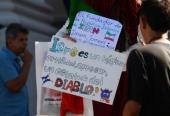The Survival of the Cuban Food Ration Card

Every January, all Cuban families receive a new card containing 12 pages according to the months of the year in which the products are allocated at grocery stores in charge of distributing a series of staples like rice, beans, cooking oil, sugar, coffee, eggs, bread, powder milk, chicken and others, in a limited amount which must be complemented with purchases at other market modalities on the island.
This historic state subsidy, which also includes special diets for the sick and pharmacy products, translates into over one billion dollars spent by the country each year to at least guarantee the equalitarian distribution mechanism.
Though, the Cuban government has been applying a policy to eliminate unnecessary subsidies for some years now, the ration card continues to be a savior for many Cubans, despite the fact that it was largely criticized for being obsolete and a symbol of this egalitarianism that characterized Cuban socialism in its first decades. The ration card was the target of jokes on the streets and the media and it still has its detractors.
For those who are not very acquainted with this issue, I would say that Cuban society has lived on many subsidies, unbelievable ones for many around the world and this has brought a heavy burden on the state, which has to buy products at high cost at the world market. I could just cite examples like the tariffs on water and phone services , the cost of a home, and other services like sewage, gas, electricity; all of them so highly subsidized that not everyone understand, unless you touch it with your hand.
Now if we look at some vivid examples, Amanda a 57-year-old woman and worker says that for her, buying a pound of rice at five Cuban pesos (twenty five cents of a dollar) is a problem, on the ration card a pound of rice is just few cents of a Cuban peso.
Amanda buys rice at five pesos by the end of the month at the offer-demand market after she consumes her ration quota, but she says that "I could not afford that rice during the whole month. For me the ration card is a big relief, actually.
According to studies, the staples that Cuban families purchase on the ration card guarantee about 36 percent of the daily calories every person needs during 12 days, while proteins cannot cover more than 10 days, fats and oils only nine days.
A UN document issue by the United Nations Assistance for Development in Cuba says that the access to that rationed food basket is a right guaranteed to all citizens.
The ration card that still survives today in Cuba is quite different from that that existed in the 1960s, since in those times it provided many more products. It cannot either guarantee a full provision of food for the whole month, but many it is an important means to access food.
Although the gradual elimination of the ration card was officially announced in December 2010, many Cubans still defend that familiar distribution mechanism, since they say that if it disappears they will face more problems and lose benefits.
In Cuba there are several market modalities, some work on offer-demand, intermediaries in between, and prices very high. Others are linked to cooperative farms with lower prices and other with topped prices managed by the army, which dedicates part of their forces to producing food for the population. State markets, which have the poorest supply, also sell at very low prices.
Some experts think that its elimination is possible, while subsidizing persons and not food as part of a systematic process, but I insist, there are many Cubans that cannot imagine their everyday life without that 52-year old friend, La Libreta or the ration card. (acn)













Add new comment